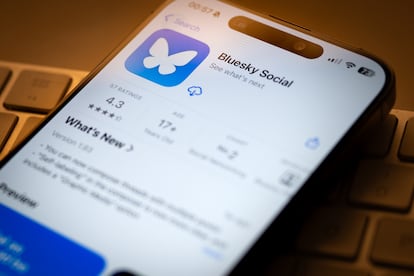Why Bluesky is different: The freedom to choose content vs the dictatorship of the algorithm
Although visually similar to the old Twitter, the social network offers features that distinguish it from the current X, making it easier for users to follow the topics that interest them

Bluesky is a micro-messaging social network very similar to the classic Twitter. Open to the public since February 2024, Bluesky surpassed 21 million users on Thursday, quickly becoming the latest major alternative to X, after other candidates like Mastodon and Threads had their moment in the spotlight.
In the United States, Canada, and the United Kingdom, Bluesky’s downloads soared from November 6, the day after Donald Trump’s victory. Just a few weeks earlier, in late October, the app was ranked below 200th in the U.S. By November 7, it jumped to 121st place, and by November 13, it had entered the top 10, according to download data from Data.ai, which tracks the Apple and Android app stores. In the U.K., the trend was similar: Bluesky rose from below 500th in October to No. 1 by November 14.
The download boom reached Spain a few days later: by last Sunday, it was the first country in continental Europe where Bluesky reached the top 3 in downloads, while the X app had vanished from the top 100. Italy, France, and Germany are following behind, but none have matched Bluesky’s success in Spain on both Android and Apple. In Latin America, the only Spanish-speaking country where Bluesky appears in the top 100 downloads is Chile. Bluesky had previously experienced spikes in South Korea, Japan, and Brazil — especially when X was banned — and in other countries where it has now gained traction. However, none of these earlier surges were as high or sustained as the current one.
The burning question now is whether Bluesky will become the new X. One of the most common arguments in favor of Bluesky is that it resembles Twitter in 2011. However, this argument has several flaws: the world is not what it was in 2011, the competitive landscape of social networks has changed, and Twitter users in 2011 are not the same age they were then.
But there are compelling arguments to say that Bluesky represents an evolution of social networks, taking them in a new direction, one that is better suited to users who have been hooked for over a decade and are now navigating a landscape crowded with numerous competing networks and messaging apps. “It is the same service, but with very different things,” says Ignacio Castro, professor at Queen Mary University of London and co-author of what is perhaps the first scientific article on Bluesky. “X, Facebook or Instagram are a monolithic construction where everything is vertically integrated. There is always a dictator who rules: the CEO, with a very clear command and control,” he adds.
Bluesky also has a CEO, Jay Graber, and a small team of 20 employees. It also receives funding from venture capital and could one day sell the network to a wealthy tycoon. But this is where the similarities end.
Bluesky offers users more control over tailoring content to their preferences, without being subject to the whims of the platform’s owner. In contrast, on X, Musk allowed blocked accounts to interact with and see those who had blocked them. Community notes have failed to curb misinformation due to their sluggishness. Additionally, X’s incentive structure — aimed at making content go viral (and generating revenue) — often leads to an overabundance of trivial, repetitive, and even plagiarized content.
On Bluesky, users seeking the latest news, celebrity banter, memes, or geopolitical commentary need not compete for attention with content pushed by algorithms. Bluesky changes this model: “If you want to create a moderation system in Bluesky, you can do so. In X, you can silence words individually, but in Bluesky you can create or subscribe to a filter of posts where churches, porn or gore appear or disappear,” says Castro.
Just as users can moderate what they don’t want to see, Bluesky also allows them to recommend content based on their personal tastes. Since April, around a thousand recommendation systems have been created by users, with a total of over 50 million unique messages, according to data collected by Castro.
The simplest way to think about these recommendation systems is by topic — such as Italian football or tropical insects — but there are many other possibilities. One of the most popular systems on Bluesky is “Popular messages between friends,” but others might include “Posts from users I follow who post the least,” for example. Castro sees an obvious business opportunity in these features: “Just like how today an email provider can hire a company to block all spam, here they could do the same with an external professional who could create filtering, promotion, and moderation systems.”
Block lists are one of the most popular content moderation options. A user can create a list of people they don’t want to see content from, for whatever reason, and share it with others. There are block lists for topics like cryptobros, Nazis, or Trump voters; it’s easy to imagine similar lists for supporters of specific teams or members of particular minority groups. If this feature becomes widely adopted, it could offer new models for studying echo chambers.
These lists can also be used to follow users when someone joins the platform or searches for people within a specific sector. Now that Bluesky is home to many academics and journalists, there are numerous lists organized by sector. But, there are also lists for users interested in a wide range of topics. The platform also allows users to verify their identity with the name of a group or organization, instead of the default “bsky.social” added to their chosen username. This feature is still in its early stages, with only 1.1% of users having a group name. The largest group currently seems to be Taylor Swift followers, with about 13,000 members: swifties.social. This allows you to change the swifties that have already registered with the default option.
It's Bluesky time
Mastodon and Threads are the other two platforms that have had their moment of success in 2024. Both still exist and maintain a loyal user base. Threads, however, has the problem of being owned by Meta, and having a pyramidal structure where thousands of users plead with Adam Mosseri, who oversees Threads and Instagram at Meta, to tweak even minor details. Mastodon, on the other hand, functions like a puzzle where each subcommunity has its own rules, and communicating with others and using the platform is less intuitive than Bluesky.
“The community that exists at the beginning dictates the dynamics. That happened in Mastodon, where many people felt that they didn’t fit in, there was a lot of open source software or fluid sexuality, for example. Now it has a large community, but it hasn’t become the mainstream of microblogging,” says Castro.
Threads boasts 275 million monthly users, but its activity is heavily influenced by Meta’s algorithm. The company is now beginning to acknowledge that giving users more control over content could be beneficial. On Tuesday, Meta announced it was testing a feature that would allow users to reset their content recommendations when they want to start fresh.
In terms of active and engaged users, Threads’ numbers are probably closer to Bluesky’s. Tech journalist Casey Newton tested both accounts after leaving X several months ago. In one month, he garnered 40,000 likes on Threads, where he posts daily, gaining 1,000 new followers, and reaching a total of 74,000 followers. On Bluesky, however, he posted only links to his articles, yet his follower count skyrocketed from 47,000 to over 100,000 in just 72 hours.
Vamos, @RafaelNadal!
— Roger Federer (@rogerfederer) November 19, 2024
As you get ready to graduate from tennis, I’ve got a few things to share before I maybe get emotional.
Let’s start with the obvious: you beat me—a lot. More than I managed to beat you. You challenged me in ways no one else could. On clay, it felt like I…
Could Bluesky discourage big accounts and be more democratic? Manlio de Domenico, head of the Complex Networks Laboratory at the Bruno Kessler Foundation in Trento, Italy, is another researcher who has explored whether the growth rate of followers and followings on Bluesky differs from X. He explains: “Imagine a user with 1,000 followers on Bluesky and on X. How many people would you expect that user to follow? On Bluesky, the result would be around 190, while on X it would be 83. And with 1 million followers? On Bluesky it would be 36,300, while on Twitter it would be around 7,000. Although on both platforms the rule that ‘the more popular you are, the fewer people you follow’ applies, on Bluesky this effect is more attenuated.”
It’s clear that this trend is happening now, although it’s unclear whether it will continue as the user base grows. But De Domenico believes it is likely: “What matters is the nature of the distribution. The gap we see probably won’t go away anytime soon, even when it stabilizes, unless the platform changes its rules,” he says.
Bluesky won’t soon become the vibrant, diverse, and even fun space that Twitter and X have been. Whether more celebrities or organizations will join, and what kind of interactions they will foster, remains to be seen. It’s also unclear whether it will attract more users, particularly younger ones, who have been driven away from Elon Musk’s X. But it’s also likely that Bluesky will create new dynamics that will make it something Twitter never was.
Sign up for our weekly newsletter to get more English-language news coverage from EL PAÍS USA Edition
Tu suscripción se está usando en otro dispositivo
¿Quieres añadir otro usuario a tu suscripción?
Si continúas leyendo en este dispositivo, no se podrá leer en el otro.
FlechaTu suscripción se está usando en otro dispositivo y solo puedes acceder a EL PAÍS desde un dispositivo a la vez.
Si quieres compartir tu cuenta, cambia tu suscripción a la modalidad Premium, así podrás añadir otro usuario. Cada uno accederá con su propia cuenta de email, lo que os permitirá personalizar vuestra experiencia en EL PAÍS.
¿Tienes una suscripción de empresa? Accede aquí para contratar más cuentas.
En el caso de no saber quién está usando tu cuenta, te recomendamos cambiar tu contraseña aquí.
Si decides continuar compartiendo tu cuenta, este mensaje se mostrará en tu dispositivo y en el de la otra persona que está usando tu cuenta de forma indefinida, afectando a tu experiencia de lectura. Puedes consultar aquí los términos y condiciones de la suscripción digital.
More information
Archived In
Últimas noticias
Aquilino Gonell, former Capitol sergeant: ‘If it hadn’t been for the police, the US would be a dictatorship’
A hybrid building: Soccer pitch, housing, and a shopping mall
Europe urges Trump to respect Greenland following annexation threats
Science seeks keys to human longevity in the genetic mixing of Brazilian supercentenarians
Most viewed
- Alain Aspect, Nobel laureate in physics: ‘Einstein was so smart that he would have had to recognize quantum entanglement’
- Mexico’s missing people crisis casts a shadow over World Cup venue
- Why oil has been at the center of Venezuela-US conflicts for decades
- Alvin Hellerstein, a 92-year-old judge appointed by Bill Clinton, to preside over Maduro’s trial in New York
- Cuba confirms death of 32 of its citizens in the US attack against Venezuela











































